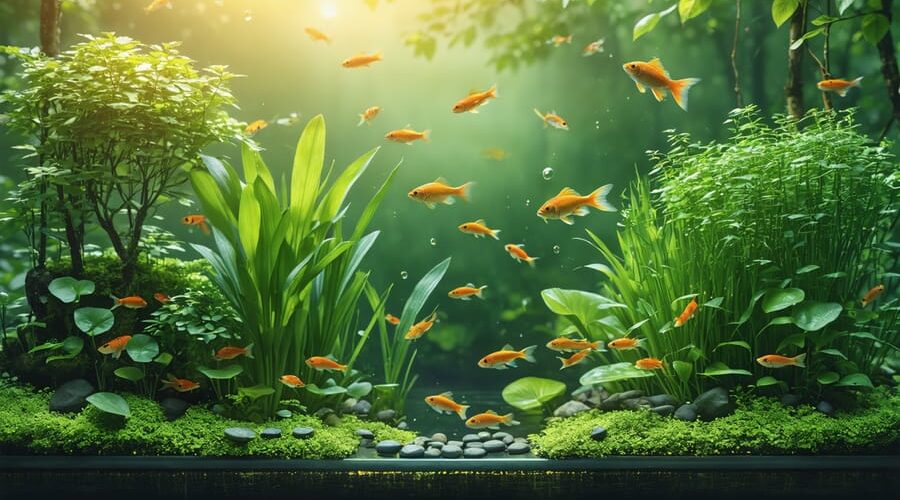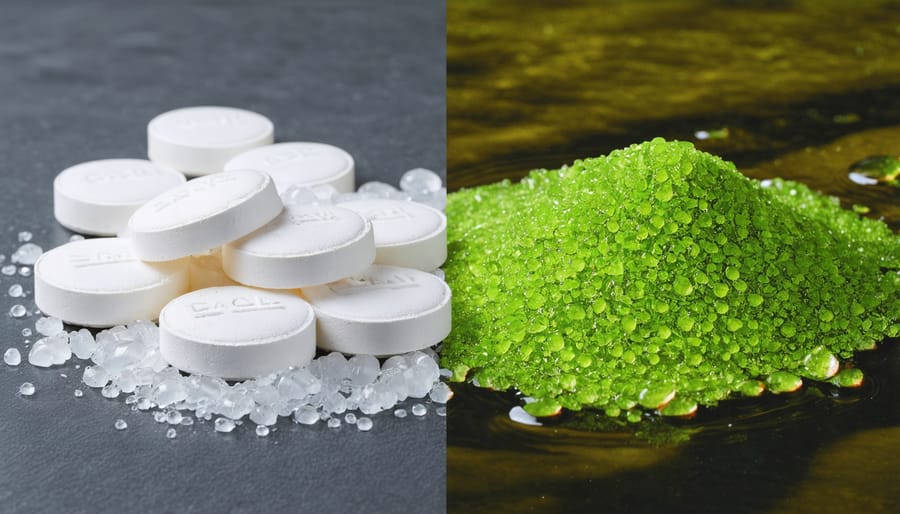
Safe Pond Fertilizers That Make Plants Thrive and Keep Fish Happy
Balance your pond’s ecosystem by choosing liquid fertilizer tablets specifically formulated for aquatic plants, ensuring they’re free from copper, ammonia, and other fish-toxic compounds. Apply root tabs directly into plant baskets or substrate, never dispersing loose fertilizer into the water column where it can trigger dangerous algae blooms. Create a thriving plant and fish ecosystem by spacing fertilizer applications 4-6 weeks apart during the growing season, using half the recommended dose initially to monitor plant and fish responses. Smart fertilization not only promotes lush aquatic plant growth but also maintains optimal water quality through natural filtration, keeping both your plants vibrant and fish healthy without the risk of chemical buildup or oxygen depletion.
Understanding Fish-Safe Plant Fertilizers
Organic vs. Chemical Fertilizers
When it comes to feeding your pond plants, you have two main options: organic and chemical fertilizers. Each has its own benefits and considerations, especially when fish are involved in your pond ecosystem.
Organic fertilizers are derived from natural sources like composted materials, blood meal, or fish emulsion. These fertilizers release nutrients slowly, which means there’s less risk of sudden water chemistry changes that could harm your fish. They’re generally safer for your aquatic friends and help build a more sustainable pond environment over time. Plus, beneficial bacteria in your pond can break down organic fertilizers more easily.
On the flip side, chemical fertilizers offer precise nutrient ratios and quick results. While they can be safe when used correctly, they require more careful handling and dosing. Look for aquarium or pond-specific chemical fertilizers that are explicitly labeled as fish-safe. These products have been formulated to dissolve slowly and won’t create dangerous ammonia spikes that could stress your fish.
For beginners, I usually recommend starting with organic options. They’re more forgiving if you accidentally add a bit too much, and they help maintain a more natural balance in your pond. If you choose chemical fertilizers, always start with half the recommended dose and monitor your fish’s behavior closely after application. Remember, a healthy pond is all about balance – you want thriving plants and happy fish!

Key Ingredients to Look For (And Avoid)
When choosing pond plant fertilizers, look for ingredients that are specifically formulated for aquatic use. Safe ingredients include:
• Slow-release nitrogen sources like blood meal or fish meal
• Natural phosphates from rock phosphate or bone meal
• Potassium from natural minerals
• Beneficial bacteria and enzymes
• Chelated iron and trace minerals
• Organic matter like seaweed extract
Equally important is knowing which ingredients to avoid, as these can harm your fish:
• Quick-release synthetic fertilizers
• Copper sulfate
• Chemical surfactants
• Artificial dyes or colorants
• Ammonia-based nitrogen
• Urea compounds
• Chemical wetting agents
The best fertilizers will typically come in tablet or spike form, which helps prevent nutrients from dispersing too quickly into the water. Look for products labeled specifically as “fish safe” or “aquatic plant fertilizer.” A good rule of thumb is to choose organic options whenever possible, as these tend to be gentler on your pond’s ecosystem.
Remember that even safe ingredients should be used in moderation. Start with half the recommended dose and observe your plants’ response before applying more. This cautious approach helps maintain water quality while still promoting healthy plant growth.
Best Fish-Safe Fertilization Methods
Tablet and Root Tab Methods
Fertilizer tablets and root tabs offer a safe, controlled way to feed your pond plants without risking your fish’s health. Simply push these slow-release tablets into the soil or planting baskets near your aquatic plants’ root systems. For best results, place one tablet for every 4 inches of pot diameter, positioning them about 2 inches deep in the substrate.
These tablets typically last 3-4 months, providing a steady nutrient supply without clouding the water or causing harmful algae blooms. When using root tabs, ensure they’re completely buried to prevent them from floating up and dissolving in the water column.
For larger pond plants like water lilies, you can use 2-3 tablets per plant. Smaller marginal plants usually need just one tablet. Always choose tablets specifically labeled as fish-safe and avoid breaking or crushing them before insertion.
Pro tip: Mark your calendar when you add tablets so you’ll know when it’s time for replacement. It’s best to fertilize during the active growing season, typically spring through early fall.

Natural Fertilization Techniques
Nature provides an excellent fertilization system for pond plants through fish waste and natural processes. As fish produce waste, beneficial bacteria break it down into nutrients that plants can readily absorb. This natural cycle creates a balanced ecosystem where fish and plants support each other’s growth.
To enhance this natural fertilization, consider adding floating plants like duckweed or water lettuce, which help absorb excess nutrients while providing additional food sources for fish. Fallen leaves from surrounding vegetation can also decompose slowly, releasing nutrients into the water.
Another effective natural technique is creating a small bog garden area within your pond. This zone can be filled with gravel and planted with nutrient-hungry species that help filter the water while thriving on fish waste. Remember to maintain appropriate fish stocking levels – typically one inch of fish per square foot of surface area – to ensure there’s enough natural fertilizer without overwhelming the system.
These natural methods not only feed your plants but also maintain water quality and create a more sustainable pond environment.
Signs of Fertilizer Problems
Being vigilant about your pond’s health is crucial when using fertilizers. Watch for fish swimming near the surface or gasping for air, as this could indicate oxygen depletion from excess nutrients. If you notice your fish becoming lethargic, losing appetite, or showing unusual swimming patterns, these might be signs that fertilizer levels are affecting water quality.
Changes in water clarity or sudden algae blooms are red flags that shouldn’t be ignored. While maintaining crystal-clear pond water is important, a sudden shift from clear to cloudy water within days of fertilizing could signal problems.
If you spot any of these warning signs, take immediate action:
– Perform a partial water change (about 25%)
– Test water parameters, especially ammonia and nitrate levels
– Temporarily stop fertilizing until water quality stabilizes
– Increase aeration to boost oxygen levels
– Remove any excess plant debris
Prevention is always better than cure. Use slow-release fertilizer tablets instead of liquid forms, and start with half the recommended dose. Monitor your pond for 48 hours after each application. Keep detailed records of when and how much fertilizer you use, making it easier to identify potential issues before they become serious problems.

Finding the right balance in your pond ecosystem is crucial for the health of both your aquatic plants and fish. By choosing fish-safe fertilizers, following proper dosing guidelines, and maintaining regular monitoring, you can create a thriving water garden where plants and fish coexist harmoniously. Remember to start with small amounts of fertilizer and adjust based on your plants’ needs. Whether you opt for tablet fertilizers, liquid solutions, or organic alternatives, always prioritize products specifically designed for pond use. With patience and careful attention to your pond’s needs, you’ll be rewarded with lush plant growth and happy, healthy fish swimming among your beautiful aquatic garden.
